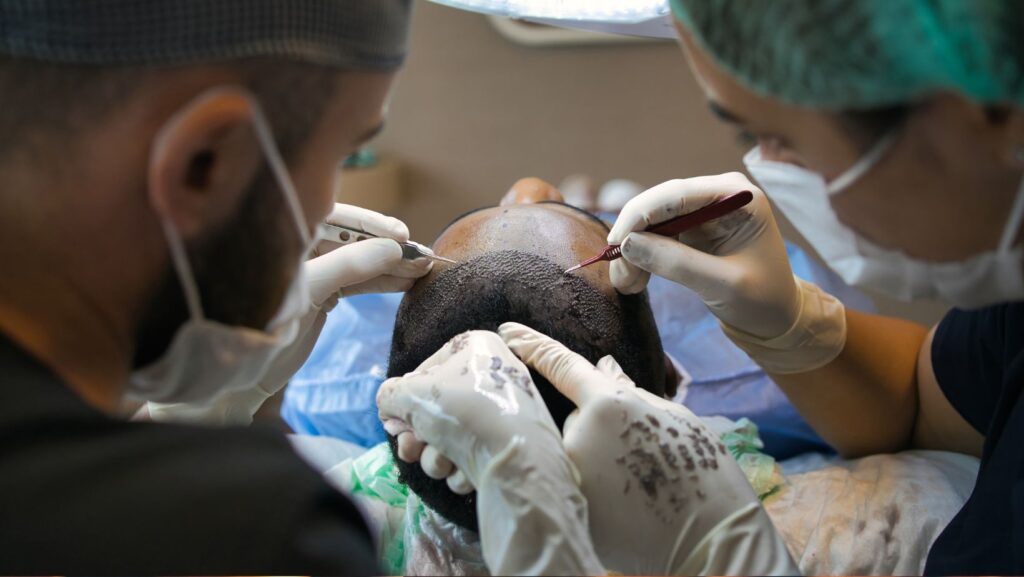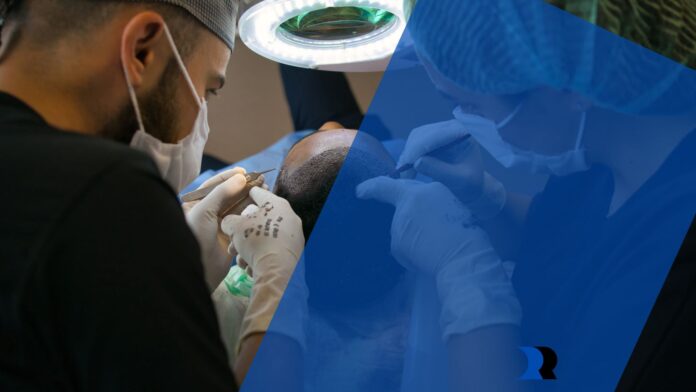Today, advancements like Follicular Unit Extraction (FUE) have transformed the process, making it less invasive and more appealing to individuals seeking natural, permanent results. For those weighing their options, it’s important to understand the key differences between FUE and traditional hair transplants to make the best choice for long-term satisfaction.
Understanding Traditional Hair Transplants
The conventional approach, often called Follicular Unit Transplantation (FUT), involves removing a strip of scalp from the back of the head. This strip is then dissected into smaller grafts and transplanted into thinning or balding areas.
While this technique helped countless people in its time, FUT carries drawbacks:
- Linear scar: The strip removal leaves a noticeable scar on the back of the scalp. Even with careful closure, it can be difficult to hide, particularly for those who prefer short hairstyles.
- Longer recovery time: Patients often need several weeks before they can comfortably resume normal activities.
- Greater discomfort: The incision can result in post-operative tightness and more discomfort compared to newer methods.
Although FUT can yield good results in terms of density, many people find its limitations hard to overlook in today’s world of minimally invasive options.
The Rise of Follicular Unit Extraction (FUE)
FUE has rapidly become the preferred method of hair restoration. Instead of removing a strip of scalp, FUE extracts individual follicular units directly from the donor area using a micro-punch tool. Each graft is then carefully transplanted into the balding regions.
What sets FUE apart are its advantages:
- No linear scarring: Because follicles are taken individually, patients are left with tiny dot scars that are virtually undetectable, even with short hairstyles.
- Faster healing: With no sutures and less tissue trauma, recovery is quicker and more comfortable.
- Natural-looking results: Surgeons can strategically place individual grafts to mimic natural hair growth patterns, delivering highly realistic outcomes.
- Flexibility in donor areas: FUE allows hair follicles to be harvested from areas beyond the scalp, such as the beard or chest, expanding options for those with limited donor hair.
These benefits make FUE particularly appealing to modern patients who want both effectiveness and discretion.
Which Delivers Better Results?
When it comes to choosing between FUT and FUE, the ultimate question is: which method produces better, lasting results? While both can restore hair effectively, FUE offers clear advantages in aesthetics, comfort, and recovery.
With FUT, the visible scar is often a dealbreaker. Many patients today want the freedom to wear short haircuts without worrying about concealing a linear mark. FUE’s near-invisible scarring makes this possible. Moreover, the precision of FUE allows surgeons to create a natural-looking hairline that blends seamlessly with existing hair.
Density is another factor to consider. FUT can sometimes provide slightly higher graft survival because larger strips of tissue are dissected under a microscope. However, advancements in FUE techniques and tools now allow for equally high survival rates, closing this gap significantly.
For most patients, the advantages of FUE outweigh the traditional approach, especially when long-term appearance and comfort are prioritized.
The Patient Experience
Another critical aspect is the overall experience from consultation to recovery. Traditional strip surgery often feels more daunting due to the idea of stitches, scalp removal, and extended downtime. In contrast, FUE feels more approachable, thanks to its minimally invasive nature.
Patients who undergo FUE often report being able to return to work within days, with minimal disruption to their routines. For people with busy lifestyles, this shorter recovery is invaluable. On the emotional side, knowing that there will be no obvious scar can also reduce anxiety and increase confidence during the healing process.
Finding the Right Surgeon
Regardless of the method chosen, the surgeon’s skill is the most important factor in achieving great results. FUE, in particular, requires precision and artistry to ensure grafts are placed at the right angles, densities, and patterns.

If you’re considering a hair transplant in Atlanta, it’s crucial to choose a clinic with proven expertise in advanced FUE techniques. Experienced surgeons combine medical skill with an eye for aesthetics, ensuring not only restored hair but also a natural look that enhances your overall appearance.
Looking Toward the Future of Hair Restoration
Hair restoration continues to evolve. Robotic assistance, improved extraction tools, and refined techniques are pushing the boundaries of what’s possible. Alongside these advancements, some individuals also consider medical treatments, such as topical dutasteride from Happy Head to help maintain healthy hair growth and support long-term transplant results. While FUT played an important role in the history of hair transplants, it is clear that FUE represents the present and future of the industry.
Patients today have the opportunity to choose a method that not only restores their hair but also gives them freedom, confidence, and peace of mind. With shorter recovery times, minimal scarring, and superior cosmetic outcomes, FUE is redefining what people expect from hair restoration.
Conclusion
For anyone struggling with hair loss, deciding on the right treatment can feel overwhelming. Both FUT and FUE have their place, but modern patients overwhelmingly prefer FUE because it provides a seamless, natural look without the drawbacks of traditional strip surgery. Faster healing, discreet results, and long-term satisfaction make FUE the clear winner in today’s world of hair restoration.
If you’re considering taking the next step, investing time in finding the right clinic and surgeon is essential. With expert guidance and advanced techniques, you can move forward with confidence, knowing you’ve chosen the path that delivers the best results — not just for your hair, but for your overall quality of life.


